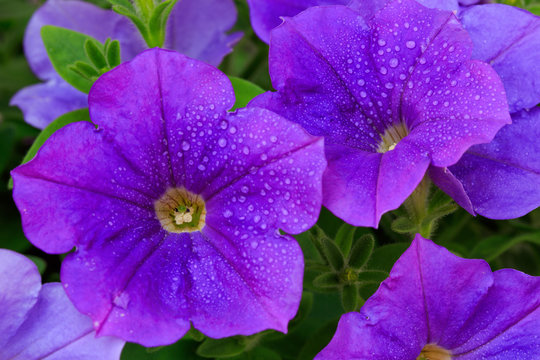Nature has a beautiful way of surprising us, and few plants capture that magic quite like the Galaxy Petunia.
With deep purple petals sprinkled in white and violet specks, these extraordinary blooms look as if they were painted by the night sky itself. Often called Night Sky Petunias or Galaxy Petunias, they truly appear to hold entire galaxies on their petals.
Let’s explore what makes them so special, how to grow them, and why they’ve become a favorite among garden enthusiasts worldwide.

What Are Galaxy Petunias?
Galaxy Petunias, also known as Petunia hybrida, are a one-of-a-kind variety known for their cosmic beauty. The white speckles scattered across deep violet or indigo petals resemble constellations, creating an effect that looks like a universe in bloom.
Each flower is entirely unique, with no two blooms ever looking the same. The intensity of the speckles can change with temperature and light, giving these flowers a living, ever-changing quality.
Key Features:
- Star-like white and violet speckles
- Velvety, trumpet-shaped petals
- Colors that shift based on light and temperature
- Long blooming season from spring through fall
These fascinating blooms bring both science and art to your garden, blending natural beauty with a hint of the cosmos.
What Creates the Galaxy Effect?
The galaxy pattern is not the result of dye or artificial treatment. It happens naturally when temperature and light interact with the flower’s pigments.
Cooler nights, below 65°F (18°C), encourage more white speckles to form, while warmer conditions can make the petals appear darker. Plenty of bright sunlight helps the contrasting colors stand out more vividly.
Because the pattern changes with weather and light, each blossom becomes a small reflection of the sky above it, constantly shifting and surprising you.
How to Grow Galaxy Petunias
Despite their exotic appearance, Galaxy Petunias are very easy to grow. With just a little attention, they can thrive in gardens, containers, or hanging baskets.
Ideal Conditions:
- USDA Zones: 9–11 (grow as annuals elsewhere)
- Light: Full sun for at least six hours daily
- Soil: Well-draining, nutrient-rich soil with a pH between 6.0 and 7.0
- Water: Keep soil moist but not waterlogged
Planting Tips:
- Start seeds indoors 10–12 weeks before the last frost, or buy young plants from a nursery.
- Transplant outdoors once the soil has warmed and frost is no longer a risk.
- Space plants 10–12 inches apart for healthy airflow.
- Add a light layer of mulch to help retain moisture.
Caring for Galaxy Petunias
To keep the blooms vibrant and maintain the starry look, consistent care is key.
Watering:
Water regularly during warm weather, keeping the soil evenly moist. Avoid getting water on the leaves or flowers to prevent fungal problems.
Fertilizing:
Feed every two to three weeks with a balanced liquid fertilizer. Use a bloom booster during midsummer to encourage more flowers.
Pruning and Deadheading:
Remove faded blooms often to encourage new ones. Trim long or leggy stems to keep the plant full and bushy.
Temperature Care:
Cooler nights bring out the white speckles. If you’re growing in pots, move them to a cooler spot overnight to enhance their galactic pattern.
Growing Galaxy Petunias in Containers or Hanging Baskets
Galaxy Petunias look spectacular in hanging baskets and window boxes where their cascading habit and rich colors can be admired up close. They blend beautifully with both modern and rustic garden designs.
Container Tips:
- Choose pots with good drainage.
- Use a premium potting mix made for flowering plants.
- Rotate containers every few days for even sun exposure.
Perfect Companions and Design Ideas
While Galaxy Petunias are stunning on their own, pairing them with other plants enhances their beauty and creates a balanced garden display.
Great Companion Plants:
- Dusty Miller (Silver Dust): Adds a silvery contrast that highlights the deep purple tones.
- Sweet Alyssum: Offers soft texture and a gentle fragrance.
- Calibrachoa (white or yellow): Brightens the display and complements the starry pattern.
- Trailing Ivy or Creeping Jenny: Adds flowing greenery for a natural layered look.
Garden Design Ideas:
- Celestial Garden: Pair with Moonflower or Night Phlox for a nighttime theme.
- Galaxy-Themed Patio: Use dark purple cushions, twinkling lights, and space-inspired decor.
- Pollinator Garden: Galaxy Petunias attract butterflies and beneficial insects, adding motion and life.
Where to Buy Galaxy Petunias
You can find Galaxy Petunias at most garden centers during spring and early summer, or order seeds and starter plants online. Look for varieties labeled as:
- Night Sky Petunia
- Purple Galaxy
- Starry Sky Burgundy
- Headliner Series (Petunia hybrida)
When grown from seed, the galaxy pattern may take a few weeks to appear as the plant matures and adjusts to your local climate.
Final Thoughts
Galaxy Petunias are a reminder that beauty and wonder exist all around us. Their star-speckled petals bring the mystery of space right into your garden, turning an ordinary planter into a little piece of the universe.
With proper care, sunlight, and the right temperature balance, you can grow flowers that look like miniature galaxies, blooming right outside your door.
Whether you are decorating a patio, creating a themed garden, or simply want something that sparks joy and curiosity, Galaxy Petunias are a perfect choice for both beginners and experienced gardeners alike.
